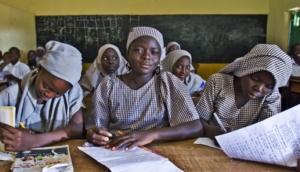
Although Progress has been recorded in recent years, girls all through their lives have continually suffered severe disadvantage and marginalization in education systems in Sub-Saharan Africa. For example, an estimated 31 million girls of primary school age and 32 million girls of lower secondary age were out of school in 2013. Also, About 100 million children worldwide 57% of them are girls, still lack access to education, suggesting that more than half children out of school children are girls. In Nigeria, the female literacy rate is 59.4% compared to the male adult illiteracy rate of 74.3%. Implying that women in Nigeria also experience gender bias in access to education as other women globally.
It must be understood that girls’ education is both a fundamental right and a vital pathway to attaining other development goals. The inability of a girl child to read, write and calculate frustrates her effort to effectively and efficiently participate in economic-driven production and household activities. This in turn negatively affects her personal well-being and reduces her potential contribution to household, local and national economic development.
Therefore,ensuring female children have access to quality education aids in breaking the cycle of poverty and encourage developments. This is because educated women are less exposed to conditions of forced child marriages and maternal mortality amongst other things, and are therefore able to acquire information and skills that lead to increased earning power enabling them to earn higher incomes, prevent unwanted pregnancies, have healthy babies and send their children to school. This cycle creates a flow of opportunity that positively influences generations unborn.
While the advantages of education to women cannot be overemphasized, several factors still limit their educational aspirations. Barriers around gender disparities and discrimination remain in place. One of the foremost limitations to girls’ educational opportunities is poverty. In situations where families are unable to cope with direct costs such as tuition fees, textbooks, uniforms and other expenses, the girls are usually the first to be denied of schooling. Strong patriarchal cultural norms which favor societal preference for boys’ education also encourage the exclusion of girls from educational systems in cases where family resources are scarce.
Addressing the issue of gender inequality in education either by reducing or eradicating it ought to be the main concern of all. To achieve this, parents, caretakers and the public need to be sensitized on the benefits of education for girls and women. Also, advocacy on equal rights, treatment and social fairness in issues pertaining to education should be promoted. Government can encourage poor parents who cannot cope with education expenses by providing scholarships/bursaries to worthy indigent female citizens. Social workers/teachers should also be authorized to report or possibly sanction parents who refuse to enroll their daughters in school, and governments should ensure such authorizations are granted.
Governments should also implement measures aimed at facilitating flexible, cost effective and accessible education for all who are interested in schooling. This would encourage women to receive good quality education. Rules and religious polices that prevent women from accessing education can be addressed through soft approaches as advocacy movements and sensitization of those concerned, on the benefits of educating women.
It is apparent that for sustainable development to occur, equal access to education is essential for both sexes. Even though it has been established that women are less educated than men, they still lack more in access to educational opportunities. This implies that not much is being done to bridge that gap. Hence, there is need to develop strategic policies, legislation and support systems that would ensure girls and women have access to cost effective and quality education. This would help build the required knowledge needed for the attainment of sustainable development and the MDGs.
- UNICEF (2007) Girls Education and Gender Inequality[http://www.unicef.org/education]
- Save the Children (2005) Achieving the Gender Parity Millenium Development Goal, What needs to be done. Policy briefing.
- UNDP (2005) Human Development Report (International Co-operation at a Cross Road. Aids, Trade and Security in an equal World).
- UNICEF (2005) A Human Rights Based Approach to Education for All.
- Fatimayin, F. (2012) Gender Inequality in Education: Implications for National Development 10 (1), 149-152.


